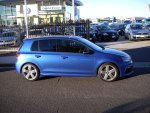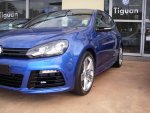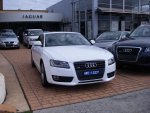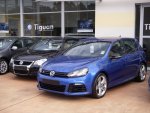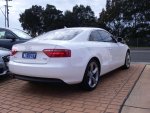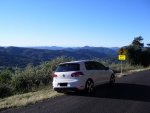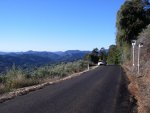2010 - BFYB title goes to Golf GTI:
My Mark 6 Golf GTI has close to 7500km on the odometer in just under 3 months. Not a drop of oil used to date. Bear in mind that my GTI spends 90% of its time on country/tourist/freeway drives. The absence of incessant warm up and cool down phases of regular short city trips would also aid in keeping oil consumption to a minimum.
GTI recently saw a longer interstate trip to South East Queensland. Had a few drives around the Gold Coast Hinterland – Mt Tamborine, Springbrook, and the northern NSW Tweed Valley inland routes snaking behind the Hinze Dam to Byron Bay.
Saw oil temps reach as high as 114 degrees Celsius going up Mt Tamborine on a 20 degree Gold Coast winters day. Highest oil temp recorded to date. Hit 111 degrees consistently traversing from Gold Coast up the winding roads to Springbrook.
Made a few more observations in the last 2,500km of touring from Sydney to Queensland Border:
EA888 TSI Mark 6 GTI motor, although more doughy with lower compression than the Mark 5 (EA113) GTI motor, the EA888 offers greater refinement and balance in the higher rev range. The earlier EA113 FSI motor in the MKV GTI had a greater NA feel to it with higher compression rate, but also offered greater vibration higher in the rev range. The EA888 has newly designed balance shafts on each side of the motor to take out some vibration from the motor, which is noticeable higher in the rev range.
The new Mark 6 GTI has inherited the intermittent squeak from the passenger’s seat base with no occupant to weigh the front left seat down – only seems to occur on rougher B-grade routes where chassis flex may occur. The B-pillar vertical plastic sheath on nearside left interior has made that infamous clicking sound several times in 7500km – not sure if it occurs with chassis flex or whether it’s a result of having the interior temperature and humidity varied against the outside temperature and humidity. The change in temps and humidity may have an effect on drying out the plastic interior. Although the Mark 6 chassis is stiffer than the outgoing MK5 Golf chassis, flex in the chassis may have moved to another location of the Golf hatchback. This could be a problem for both the GTI and Golf R.
Oh yeah – the sun visor cover for the small face mirror often rattles when closed with the sun driver’s sun visor pulled down. The cruise control, when decreased in single digits with separate prongs on the stalk, km/h reverts up to the 5th digit when going down to the zero digit (i.e. 85 – 84 – 83 – 82 – 81 - 80 – 85) – only a minor concern. Finally – exhaust scavenging is still apparent – more so under load between 2400 – 2600rpm and not really an issue on protracted highway cruises/long trips, unlike some drone from the Golf R on the highway.
Fuel consumption for journey from South Coast Sydney to Surfer Paradise and return on the Pacific Hwy – door to door – averaged 6.75 litres per 100km, showing an improvement on the older MKV GTI. Considering that Mark 6 GTI motor was still a bit tight, running on less slippery mineral break-in oil and not strictly driving for best economy in varying the revs from time to time as the TSI is still fairly new. A strict economy run in the old MKV GTI with DSG in drive mode and using Pacific Hwy and alternative New England Hwy had a best of 7.0 litres per 100km door to door for the same trip. Mark 6 GTI already showing an improvement in economy over the previous model GTI. Hopefully a full economy run will yield @ 6.5/6.6 litres per 100km for the same trip once completely run-in and using super slippery full synthetic oil after 15,000km service. Fuel consumption working the motor harder up Springbrook Mountain Drive and Mount Tamborine in Queensland had the GTI’s fuel consumption reading showing @ 9.0 litres per 100kms, which is very good indeed imo.
My thoughts on Dynamic Chassis Control (DCC) after 7,500km including an interstate journey:
Well worth the money for a street driven vehicle. For competition, you’d want something a bit stiffer in spring & damper rate. I used Normal mode for entire trip from Sydney to Queensland. Mt Tamborine climb had Normal and Sport modes as roadways further up Mt Tamborine can be quite rough in texture.
The drive from Gold Coast (Nerang) to Springbrook Mountain involved having the DCC in normal mode for first half of the mountain climb as a test on driver satisfaction, enjoyment and feeling. After the first half of the Springbrook Mountain climb of this fantastic route, I opted for DCC Sport mode. The DCC steering mode in Normal to too light to make for a cohesive drive – the driver and Golf GTI failing to gel with a certain type of awkwardness when climbing the hilly bends (think NSW Macquarie Pass near Wollongong, only longer and more flowing) with the GTI having a tad too much body lean at the lower speeds and too much driver effort required into lighter steering around the closely knit string of bends leading up the valleys.
DCC into Sport mode at half way was spot on in terms of chassis adjustment for the climb up to Springbrook in Queensland’s South East Hinterland. In DCC Sport the GTI sits flat on its springs, EDL/XDS unobtrusively aids the punch out of tight corners when driving responsibly within limits smoothly and consistently stringing a series of bends together. ESC does not cut in, rather acting in an unobtrusive way (Golf R has EDL at the front for lower speeds; but not XDL). The larger Mark 6 rear sway bar (MK6 24mm –v- 22mm MKV) also aids in reducing understeer. The added weight and directness of DCC Sport steering provides for that direct connection between driver and vehicle, and coupled with the flat stance of the chassis, really does transform the drive experience.
Alternatively: The drive from Gold Coast via – Nerang – Murwillumbah – Byron Bay – the hinterland route through the Tweed Valley had DCC in a combo of Sport and Normal - mostly Sport with me putting up with a terse ride on the rougher sections of flowing bends leading up to the Queensland – NSW border just for the better driver experience; then Normal leading up to & around the township of Murwillumbah, returning to Sport out of Murwillumbah to Bryon Bay along the old Pacific hwy flowing roadways. DCC soft was used to climb Cape Bryon to Byron Bay lighthouse – that’s a rough bit of tourist roadway for a popular tourist destination.
Great thing about DCC is that it softens or hardens the damper tune according to speed. I have noticed, and it has been stated on another review on Ausmotive.com.au re: Golf R that when Dynamic Chassis
Control is in the hard Sport mode, steering kickback may occur from time to time on mid corner upsets.
I’ve experience some mild kickback on the GTI on occasions with DCC in Sport when negotiating rougher B-grade roadways. This is something that I never experienced in the old MKV GTI, despite having up to six different suspension combinations and the last of those combinations being a much firmer & stiffer KW V3 coil over suspension and H&R solid adjustable sway bars front & rear. Steering kickback does not occur when DCC is in Normal or Comfort modes – only Sport.
Amazed at how flat the GTI sits with DCC in any setting, esp. harder Sport mode, without the use of aftermarket adjustable sway bars as I had on my old MKV GTI. The aftermarket heavy duty solid sway bars really do sharpen & quicken the one wheel bumps creating a brittle type of ride over these similar routes (esp. Mt Tamborine) when fitted to the old MKV GTI. In contrast, the new Mark 6 GTI settles into uneventful slight understeer when pressing on, but offers a much improved ride. When in either Sport or Comfort mode and travelling at faster speeds, the DCC electronic dampers can be caught out in the first ¼ of a second when striking big roadway hits. In this respect, I’m guessing the more expensive & reactive Audi/HSV/Ferrari magna-tec dampers may work that bit faster than Dynamic Chassis Control.
I see the Golf GTI won the MOTOR Magazine ‘Bang for Your Buck’ 2010 title.
It’s easy to see why from the perspective of usability and all-round ability of the Mark 6 Golf GTI. Strictly speaking, the Golf R and more importantly, the Renault Clio 200 Cup would offer more bang for your buck. Problem with both the Golf R and Renault Clio is that you have to put up with each vehicles idiosyncrasies for that added performance.
In Renault Clio’s case: smaller vehicle, 3 door only, terse low speed ride, lack of low end torque, manual only option. In the Golf R’s case: Turbo lag creating lack of excitement lower down in the rev range, vehicle not being able to be used to full extent on public roadways regarding it’s very high grip threshold and peaky large turbo engine response, extra weight creating lack of adjustability on the throttle in public roadways and added fuel consumption.
Not surprising to see that Golf GTI with fast spooling small turbo'ed EA888 motor is only 0.1 seconds slower than the Golf R in the crucial 80-120kph real world performance test. 0-1.0km acceleration test has the GTI only 1 second slower than the Golf R over the full 1km run - impressive. No difference in braking ability in either stopping power or consistency between the Golf R and Golf GTI, according to MOTOR magazine. Most importantly – WJ has not rushed out to trade his White GTI in for a Golf R. Very happy with the Golf GTI ownership and drive experience, despite some minor squeaks and rattles.
Re: Idiosyncrasy of Golf R – see link from this forum:
http://www.rforum.co.uk/index.php?topic=833.15
Cheers
WJ

